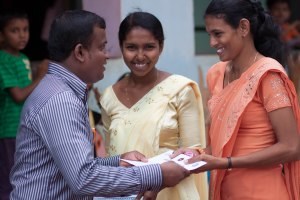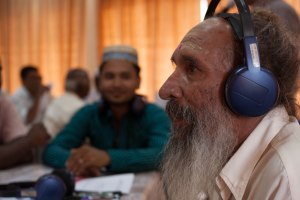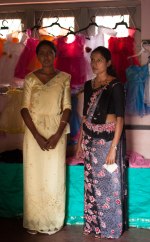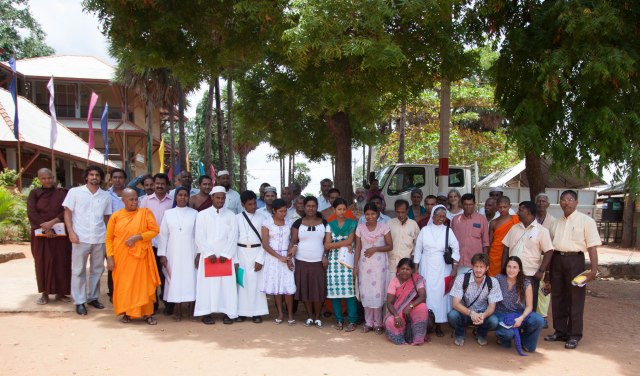A Buddhist monk, Christian priest, Hindu priest and Muslim imam walked into the room… It sounds like the beginning of a cheesy joke, but these religious leaders were serious.
Forty religious leaders arrived at the Sarvodaya Trincomalee District Center to attend an inter-religious workshop. This workshop was part of a year and half project to bring together religious leaders from the Eastern provinces – Trincomalee, Padaviya, and Batticaloa – to learn about each other, build relationships and work together to achieve a brighter future. But Sarvodaya was not coordinating this project alone… USAID (“from the American people”) is providing the funds for this project while the Karuna Center in Massachusetts is co-facilitating it alongside Sarvodaya. The entire project’s duration is a year and a half, this workshop being the third one at the close of one year. In previous workshops, the leaders, eighty in total, established community projects that would bring together members of different faiths to unite around one goal, whether learning how to sew, speak English, or use the computer.

Participants of a sewing project in Padaviya receive certificates for completion of their training. This vocational project brought Sinhalese Buddhist and Christian women to sew side by side
Olivia, executive director of Karuna Center in the US, came to Sri Lanka to lead the workshop. Having worked in several countries and in various conflict contexts, she was very familiar with the post-war symptoms experienced by the Sri Lankans – distrust of the government and their ethnic neighbors, fear of the “other” (whether it be Muslim, Buddhist, Hindu or Christian) and, more significantly, uncertainty on how to proceed into the future. While her expertise allowed her to engage and address a variety of conflicts, Olivia’s international workshop model meant she was distant from this conflict. Some history cannot be understood by having a conversation or reading the news; they can only be understood through forming deep relationships with the locals and cultivating an awareness that is possible only with time and patience.
I remind myself that the goal here was not to attain such an understanding, but to teach the religious leaders certain tools which they can use in their communities. At this, the workshop was quite successful.

The bulky headsets used for translations appeared misplaced on the heads of these leaders. I don’t think the majority of them ever used a headset before.
The workshop contained many lessons. The leaders were taught the differences between dialogue (“a conversation that seeks understanding”) and debate (“an argument where one side wins, one side loses”). They were introduced to the Do No Harm model for peace and development. The model is founded on the principles of critical analysis and self-critique with the aim of determining the circumstantial outcomes of peace and development projects. The model presupposes a deep division in society that can be seen through identifying “connectors” and “dividers” between people. A project is then analyzed in terms of connectors and dividers to determine how a project may exacerbate dividers or increase connectors. The idea behind this entire analysis was, of course, to ensure the project utilized and maximized the connectors while avoiding increasing dividers.
This analytical process was foreign to the participants. They did not readily see the connectors and dividers between themselves, which meant they had difficulties determining how their community projects ‘fit’ in the broader scheme of establishing peace. But many did see their language as either a divider (between Sinhalese Buddhist and Hindu Tamils) or connector (between Muslims and Hindu Tamils). Thus, language education classes (Sinhalese-Tamil) were seen as advantageous, since they minimized the significance of their language divider.
Perhaps what impressed me most about this workshop is the degree to which the Muslims, Buddhists, Christians and Hindus became comfortable with one another. I was not here last year at the start of the program, but I was told that there was a tangible tension between members of the different faiths. Now – especially a day into the program – the participants were sitting together regardless of their faith, and I could see them laughing often and exchanging words freely.
While this workshop was a reflection of Sarvodaya’s interest in establishing peace, it strayed far from the spiritual and cultural approach of Sarvodaya. There was discussion on cultivating certain qualities, like the ability to listen to others and mediate disputes while maintaining neutrality. But spirituality was absent altogether, and so too were discussions around qualities like metta (loving-kindness), mudita (empathetic joy) and uppekkah (equanimity). It was a Western model imported to address a particularly Sri Lankan problem, the consequences of which are still unclear to me. But the foreign nature of the program was palpable to the naked eye, from the large logo of USAID and KARUNA CENTER to the bulky headsets the participants had to use.
As a matter of US State policy, Olivia options for lodging were restricted to the top-end hotels with nightly price-tags that exceed the cost of 200 Sri Lankan meals. Is such a foreign aid and development policy irrelevant to the project’s goal? Or, rather, does such a policy reflect the project’s more covert – unintentional I’m sure – agenda? The walls surrounding Olivia’s hotel “protect” her from Trincomalee. Elements of Sri Lanka seep into the establishment only after being carefully filtered and organized to please the wealthy guests. Excursions outside of the fortress are escorted and manicured in an attempt to conceal the awkwardness and confusion that arises when two cultures come together. The “power of the West” is locked to the Westerner, and she cannot untangle herself from it no matter where she goes. Exposure is thus controlled and a hierarchy of power imposed. I fear that moral equality, the idealistic precondition for genuine exchange and growth, was quarantined with the Western stamp of approval.

